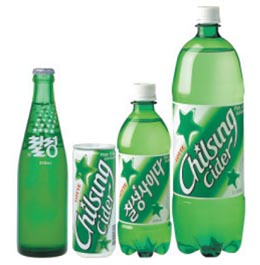7 men in an old caramel plant brewed an icon

Chilsung Cider
This cultural icon was the work of Park Woon-suk, who majored in the study of soft drinks in Japan and served as a manager at the Kumgang cider factory in Pyongyang during the 1940s. As Pyongyang’s political situation worsened, Park decided to move to the South and develop a new carbonated drink with Choi Keum-duk and others, who were running a clothing factory there.
When Park defected to the South in 1947, he brought with him an infuser and mixer. Choi sold his factory and gave Park the money for his new venture. Four refugees and a man from Dangjin joined, and the group grew to a total of seven people. They built a factory and an office in Yongsan District, central Seoul, in what used to be a caramel factory run by a Japanese businessman.
The first bottle of Chilsung Cider was produced on May 9, 1950. The name, which literally means “seven names” in Chinese letters, reflected the seven shareholders, who all had different family names. Later, the company changed the second syllable to mean “stars.”
The developers of the drink had realized that previous cider drinks all had problems because of water impurities, and so they focused on refining the most basic ingredient - the water.
In 1966, they replaced the Japanese flavors they had used in the early days with natural flavorings from the Netherlands, extracted from lemons and limes. The group developed its own recipe for Chilsung Cider, mixing clean water, natural flavorings, sugar and citric acid, though it’s never revealed exactly how much of each ingredient goes into each bottle. Only a few at the company’s research center and production line have access to the recipe.
The corporation producing Chilsung started as Dong Bang Beverage Company in 1950 before changing its name to Chilsung Hanmi Beverage in 1973. A year later, Korean food and retail giant Lotte bought the company. But through all the tumult, the integrity of the secret recipe was never disturbed.
With competition in the beverage market growing fiercer in the 1980s, Chilsung fought back by cultivating an image of purity in its advertising, touting its beverage’s “Three Nos: no color, no caffeine, no artificial flavorings.” Lotte took a risk by shooting a television advertisement for the drink at Mount Paektu in 1991, when Korea had no diplomatic ties with China. At the time, the film was seized by the Chinese authorities. However, eventually it was given back and the advertisement aired.
Chilsung Cider sales peaked in 2004 at 340 billion won ($300 million). The figure stood at 270 billion won last year. Despite all the new entrants, Chilsung still accounts for 78 percent of the cider market, the company said, and in the last six decades, more than 15 billion bottles have been sold.
By Choi Ji-young [ebusiness@joongang.co.kr]










with the Korea JoongAng Daily
To write comments, please log in to one of the accounts.
Standards Board Policy (0/250자)